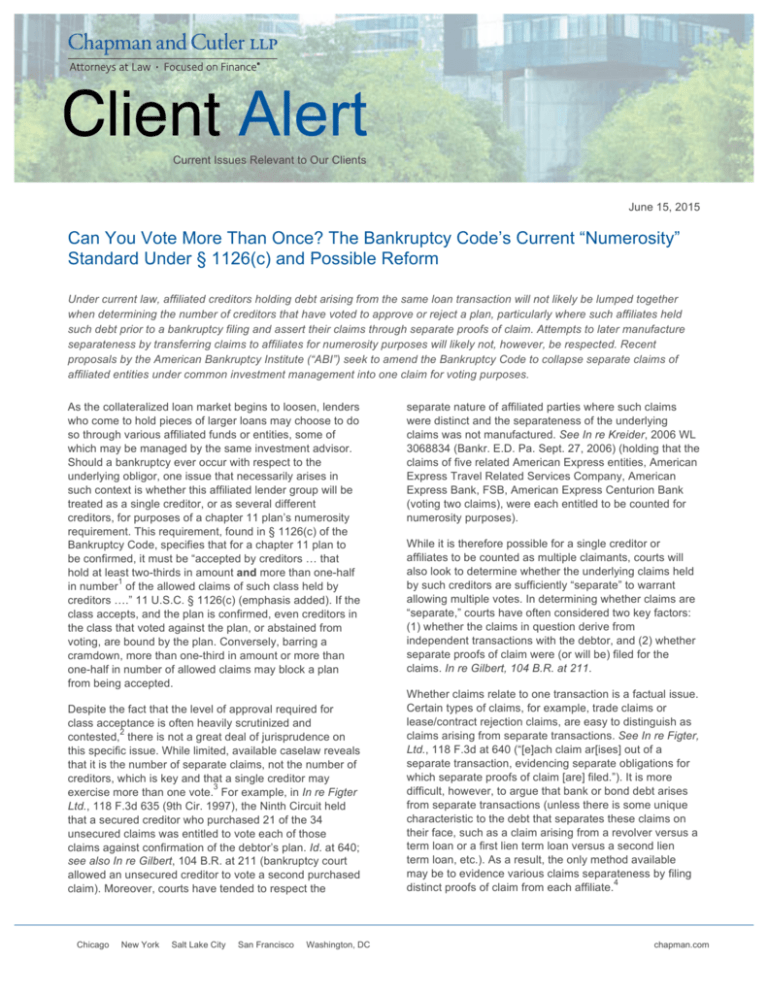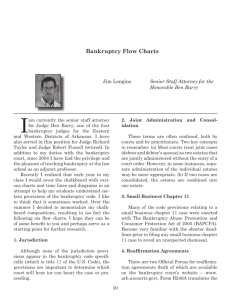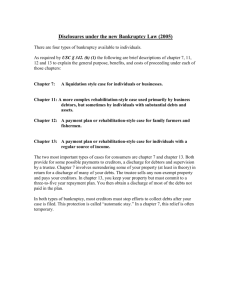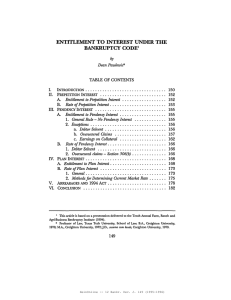
Client Alert
Current Issues Relevant to Our Clients
June 15, 2015
Can You Vote More Than Once? The Bankruptcy Code’s Current “Numerosity”
Standard Under § 1126(c) and Possible Reform
Under current law, affiliated creditors holding debt arising from the same loan transaction will not likely be lumped together
when determining the number of creditors that have voted to approve or reject a plan, particularly where such affiliates held
such debt prior to a bankruptcy filing and assert their claims through separate proofs of claim. Attempts to later manufacture
separateness by transferring claims to affiliates for numerosity purposes will likely not, however, be respected. Recent
proposals by the American Bankruptcy Institute (“ABI”) seek to amend the Bankruptcy Code to collapse separate claims of
affiliated entities under common investment management into one claim for voting purposes.
As the collateralized loan market begins to loosen, lenders
who come to hold pieces of larger loans may choose to do
so through various affiliated funds or entities, some of
which may be managed by the same investment advisor.
Should a bankruptcy ever occur with respect to the
underlying obligor, one issue that necessarily arises in
such context is whether this affiliated lender group will be
treated as a single creditor, or as several different
creditors, for purposes of a chapter 11 plan’s numerosity
requirement. This requirement, found in § 1126(c) of the
Bankruptcy Code, specifies that for a chapter 11 plan to
be confirmed, it must be “accepted by creditors … that
hold at least two-thirds in amount and more than one-half
1
in number of the allowed claims of such class held by
creditors ….” 11 U.S.C. § 1126(c) (emphasis added). If the
class accepts, and the plan is confirmed, even creditors in
the class that voted against the plan, or abstained from
voting, are bound by the plan. Conversely, barring a
cramdown, more than one-third in amount or more than
one-half in number of allowed claims may block a plan
from being accepted.
Despite the fact that the level of approval required for
class acceptance is often heavily scrutinized and
2
contested, there is not a great deal of jurisprudence on
this specific issue. While limited, available caselaw reveals
that it is the number of separate claims, not the number of
creditors, which is key and that a single creditor may
3
exercise more than one vote. For example, in In re Figter
Ltd., 118 F.3d 635 (9th Cir. 1997), the Ninth Circuit held
that a secured creditor who purchased 21 of the 34
unsecured claims was entitled to vote each of those
claims against confirmation of the debtor’s plan. Id. at 640;
see also In re Gilbert, 104 B.R. at 211 (bankruptcy court
allowed an unsecured creditor to vote a second purchased
claim). Moreover, courts have tended to respect the
Chicago
New York
Salt Lake City
San Francisco
Washington, DC
separate nature of affiliated parties where such claims
were distinct and the separateness of the underlying
claims was not manufactured. See In re Kreider, 2006 WL
3068834 (Bankr. E.D. Pa. Sept. 27, 2006) (holding that the
claims of five related American Express entities, American
Express Travel Related Services Company, American
Express Bank, FSB, American Express Centurion Bank
(voting two claims), were each entitled to be counted for
numerosity purposes).
While it is therefore possible for a single creditor or
affiliates to be counted as multiple claimants, courts will
also look to determine whether the underlying claims held
by such creditors are sufficiently “separate” to warrant
allowing multiple votes. In determining whether claims are
“separate,” courts have often considered two key factors:
(1) whether the claims in question derive from
independent transactions with the debtor, and (2) whether
separate proofs of claim were (or will be) filed for the
claims. In re Gilbert, 104 B.R. at 211.
Whether claims relate to one transaction is a factual issue.
Certain types of claims, for example, trade claims or
lease/contract rejection claims, are easy to distinguish as
claims arising from separate transactions. See In re Figter,
Ltd., 118 F.3d at 640 (“[e]ach claim ar[ises] out of a
separate transaction, evidencing separate obligations for
which separate proofs of claim [are] filed.”). It is more
difficult, however, to argue that bank or bond debt arises
from separate transactions (unless there is some unique
characteristic to the debt that separates these claims on
their face, such as a claim arising from a revolver versus a
term loan or a first lien term loan versus a second lien
term loan, etc.). As a result, the only method available
may be to evidence various claims separateness by filing
4
distinct proofs of claim from each affiliate.
chapman.com
Chapman and Cutler LLP Client Alert
June 15, 2015
Attempts to manufacture separateness, however, by
splitting pieces of a loan into various affiliates may not be
permitted. To date, no court has expressly prohibited such
practice or collapsed the holdings of affiliates into one
vote. The Ninth Circuit, however, has stated in dicta that
“of course, that is not to say that a creditor can get away
with splitting one claim into many, but that is not what
happened here.” In re Figter, 118 F.3d at 641.
4
The Bankruptcy Code allows each creditor to file a proof of
claim, even if the result is that multiple claims will be filed
which all relate to the same underlying transaction. See
Rule 3001 of the Bankruptcy Rules.
5
See ABI Report at 259.
For More Information
While current law would therefore tend to indicate that
claims of affiliated lenders may be treated as separate to
the extent documented by different proof of claims,
allowing affiliates to count as different creditors for
numerosity purposes, change may be ahead. The ABI’s
Commission to Study the Reform of Chapter 11 recently
released its report to amend the Bankruptcy Code. Among
the proposals contained therein is amending the
numerosity requirements to specify that all affiliated
entities under common investment management should be
treated as a single creditor. Such reform is primarily
directed at investment advisors and other parties that
strategically purchase loans in the secondary market,
often after a plan has been filed, who the Commission
accuses of “significant gamesmanship” with respect to
5
voting and classification of claims.
For more information, please contact any of the following
attorneys or any other Chapman attorney with whom you
regularly work:
Any amendment to the Bankruptcy Code based on such
proposals is likely years away. Given the limited caselaw
on this issue, however, and the importance that
bankruptcy judges place on the recommendations of the
ABI’s Report, judges may be influenced to count claims
related to a single loan transaction held by various
affiliates as one claim for purposes of numerosity,
notwithstanding that each party has filed a distinct proof of
claim. We will continue to watch this area of law.
Litigation, Bankruptcy and Restructuring
1
Also known as the “numerosity” requirement.
2
Much of the jurisprudence in this area arises in the context
of vote designation, whereby a creditor’s vote is invalidated
for, among other things, a lack of “good faith.” See In re
DBSD North America, 634 F.3d 79 (2d Cir. 2011) (holding
that Bankruptcy Court did not err in designating the vote of
a competitor who purchased a blocking position after the
filing of a plan in order to control the bankruptcy process).
Importantly, the DBSD court noted that “[w]e leave for
another day the situation in which a preexisting creditor
votes with strategic intentions.” Id. at 105.
3
See In re Gilbert, 104 B.R. 206, 210 (Bankr. W.D. Mo.
1989) (“The formula contained in Section 1126(c) speaks in
terms of the number of claims, not the number of creditors,
that actually vote for or against the plan.” citing In re
Jeppson, 66 B.R. 269, 294 (Bankr. D. Utah 1986)); and In
re Jartran, 44 B.R. 331, 364 (Bankr. N.D. Ill. 1984)
(referring to number of ballots received based on the
“amount of claims voted”).
Chicago
New York
Salt Lake City
San Francisco
Washington, DC
Banking and Financial Services
Anthony M. DiGiacomo
212.655.2530
New York
Larry G. Halperin
212.655.2517
New York
Steven G. Hastings
312.845.2958
Chicago
James R. Theiss, Jr.
312.845.3891
Chicago
Nicholas A. Whitney
212.655.2546
New York
Michael Friedman
212.655.2508
New York
Craig M. Price
212.655.2522
New York
Franklin H. Top, III
312.845.3824
Chicago
This document has been prepared by Chapman and Cutler LLP attorneys
for informational purposes only. It is general in nature and based on
authorities that are subject to change. It is not intended as legal advice.
Accordingly, readers should consult with, and seek the advice of, their own
counsel with respect to any individual situation that involves the material
contained in this document, the application of such material to their specific
circumstances, or any questions relating to their own affairs that may be
raised by such material.
To the extent that any part of this summary is interpreted to provide tax
advice, (i) no taxpayer may rely upon this summary for the purposes of
avoiding penalties, (ii) this summary may be interpreted for tax purposes as
being prepared in connection with the promotion of the transactions
described, and (iii) taxpayers should consult independent tax advisors.
© 2015 Chapman and Cutler LLP. All rights reserved.
Attorney Advertising Material.
2











